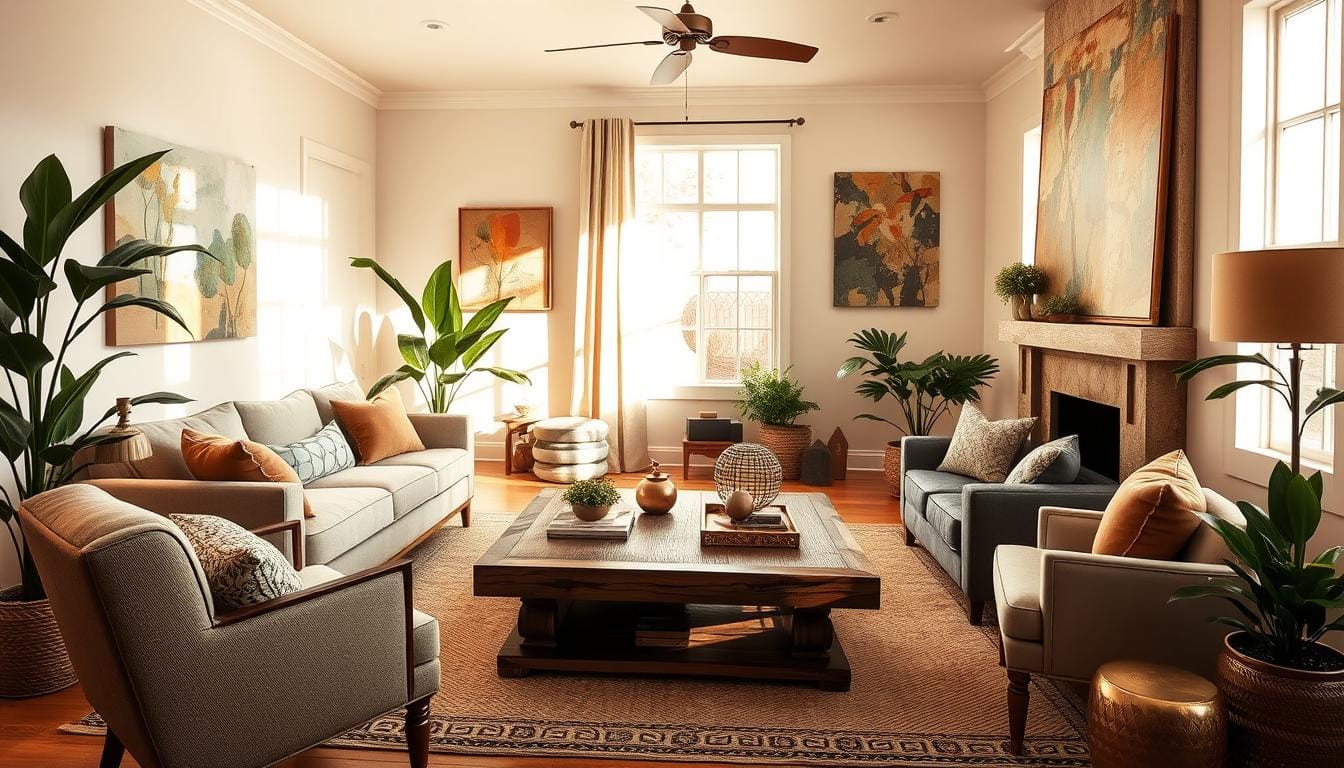Last winter, I faced a decorating challenge that changed my perspective completely. My best friend texted: “Help! My space feels like a furniture showroom – cold and impersonal.” When I walked into her apartment, I understood immediately. Blank walls, mismatched pillows, and lighting that made everything feel sterile. But here’s the secret – small changes created jaw-dropping results in just one weekend.
We started with what I call the “three-layer rule” – texture, color, and personality. A chunky knit throw here, warm-toned accent wall there, and family photos in eclectic frames. Suddenly, her space felt like a true reflection of her vibrant spirit without breaking the bank.
This experience taught me that great design isn’t about perfection. It’s about creating areas that spark joy and connection. Whether you’re refreshing a studio apartment or reimagining a family hub, I’ll share the same practical strategies we used – from clever lighting hacks to space-maximizing layouts.
You’ll discover how to blend function with style using items you already own. Ready to turn your space into a place that truly feels like home? Let’s dive in!
Setting the Scene for a Cozy Living Room
It all began with a client who hated her beige walls but feared color. We spent hours flipping through magazines until she paused at a photo of an unexpected sage-green space. “That’s it!” she exclaimed. Designer Amber Lewis calls this the “aha moment” – when a hue you’d never consider becomes your perfect match.
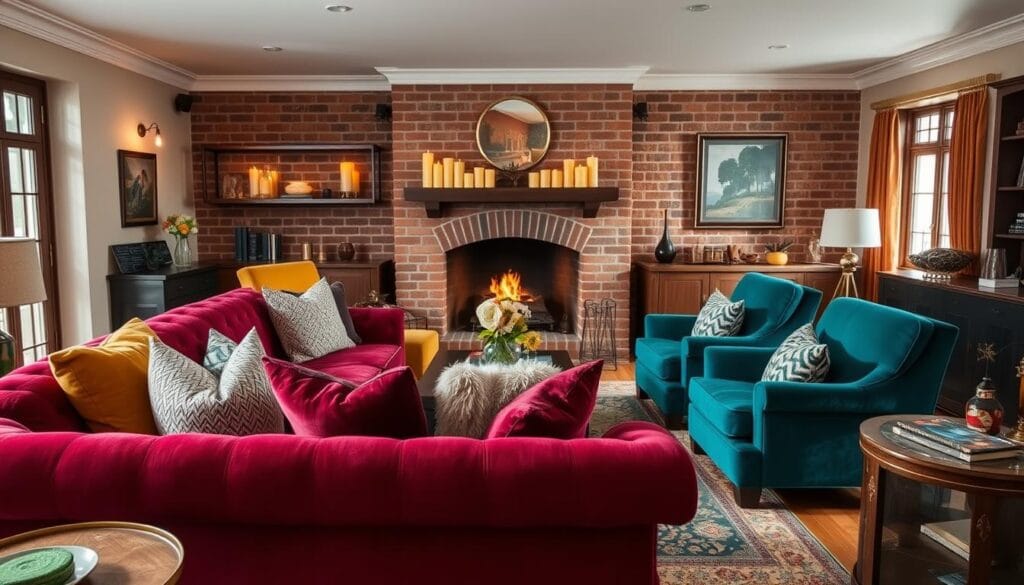
Defining Your Personal Style
Start by asking: “What spaces make me feel most relaxed?” Maybe it’s your favorite coffee shop’s rustic charm or a boutique hotel’s sleek lines. I’ve found most people gravitate toward three core aesthetics:
- Clean-lined modern minimalism
- Warm, textured farmhouse
- Layered boho with global accents
Choosing a Soothing Color Palette
Lewis’s genius trick? Test colors at different times of day. That soft peach that glows at noon might turn neon under evening lamps. Try these steps:
- Paint large poster boards (not tiny swatches)
- Place them near furniture and art
- Observe morning, noon, and night
For instant cohesion, pull shades from a favorite rug or artwork. Need inspiration? These proven cozy formulas work like magic.
Curate Character with Secondhand Finds
I’ll never forget the thrill of uncovering a vintage brass lamp buried under garage sale clutter. Designer Alison Giese’s garden cottage project taught me something vital: soulful spaces aren’t built overnight. They’re crafted through patient discovery. That lamp? It now anchors a client’s reading nook, whispering stories only aged patina can tell.
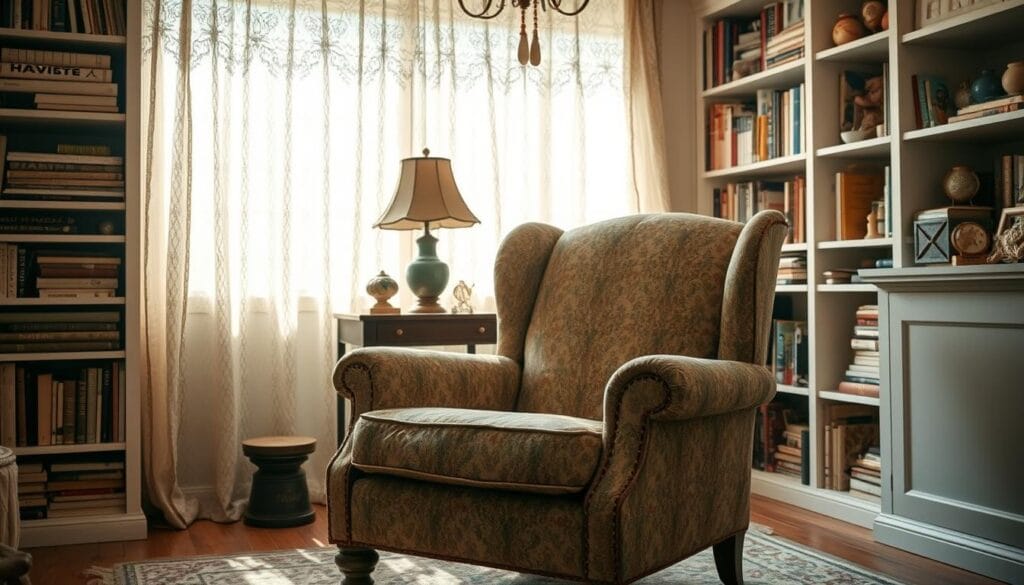
Thrifting for Unique Accent Pieces
Slow decorating changed everything for me. Instead of rushing to fill shelves, I now hunt with purpose. At a Texas flea market last spring, I found walnut side tables with dovetail joints – real craftsmanship hiding under chipped paint. Here’s how to spot gems:
- Flip furniture to check for solid wood construction
- Test drawer slides and door hinges
- Look for unusual shapes that modern stores don’t stock
Mixing eras creates depth. Pair mid-century chairs with an Art Deco mirror, or layer folk art beside sleek ceramics. The key? Repeat one color across pieces to unite mismatched styles. For those craving warmth, these cozy living room ideas blend perfectly with vintage finds.
My favorite trick? Let imperfect items shine. A water-stained sideboard becomes a conversation starter when topped with modern glassware. Remember: every scratch adds character you can’t fake.
Elevate with Creative Lighting Solutions
I once helped a couple transform their cavernous loft using nothing but clever illumination. Their space went from “echo chamber” to “urban oasis” through strategic fixture choices. Lighting isn’t just functional – it’s emotional alchemy that reshapes how we experience our surroundings.
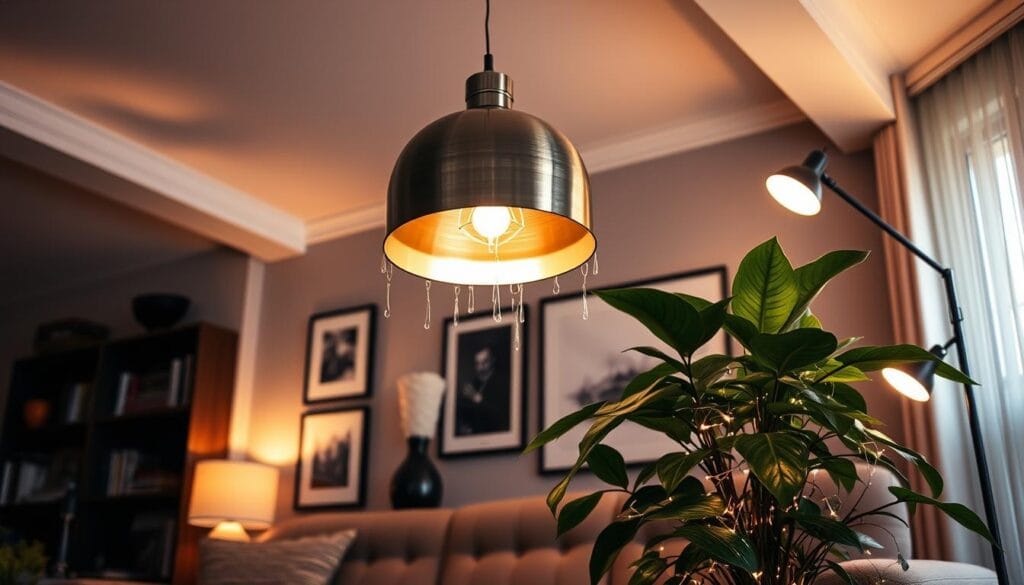
Pendant Lights and Ambient Fixtures
Designer Alison Giese taught me a genius trick with oversized pendants. In that lofty great room, eight-foot fixtures created visual anchors, making vaulted ceilings feel inviting rather than intimidating. Here’s how to apply this:
- Choose fixtures 1/3 the length of your ceiling height
- Cluster smaller pendants over conversation areas
- Use warm bulbs (2700-3000K) to avoid sterile vibes
Using Light to Change the Mood
Dimmer switches are my secret weapon. I recently installed them in a client’s open-concept area, creating three distinct zones:
- Bright task lighting for morning coffee prep
- Medium glow for afternoon Zoom calls
- Soft ambiance for evening wine tastings
Position lamps at eye level to eliminate harsh shadows. Try angling a spotlight behind your favorite plant – instant drama without renovations!
Embrace Bold Patterns and Textures
Three years ago, I nearly fainted when a client asked me to mix leopard print with floral pillows. Today? I can’t imagine designing without bold patterns. Designer Heather French’s den project changed everything – she layered stripes, ikat, and botanical prints using one navy anchor color. The result? A space bursting with energy that still felt cohesive.
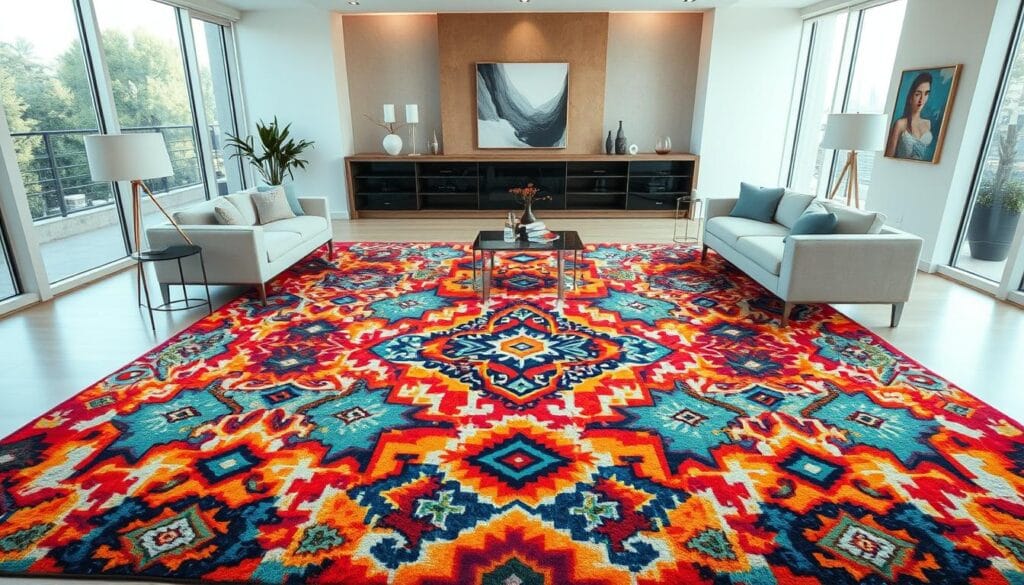
Mixing Patterns for Visual Interest
French’s golden rule? Keep 60% of your palette neutral. In that navy den, cream walls and charcoal furniture let vibrant patterns shine without chaos. Try this formula:
- Large-scale print on curtains or area rugs
- Medium pattern on accent chairs
- Small motif for throw pillows
I recently used this approach with a tattoo artist’s snake-print rug. We balanced its wild energy with solid velvet cushions and geometric curtains in matching teal tones.
Textured Rugs and Upholstery Choices
Texture adds depth even in neutral spaces. A nubby linen sofa becomes irresistible when paired with a silky mohair throw. For high-traffic areas:
- Choose flat-weave rugs with subtle patterns
- Use performance fabrics on seating
- Layer sheepskins over structured armchairs
That snake-pattern carpet? It taught me bold designs work best when grounded. We surrounded it with matte black furniture and smooth leather ottomans – proof that contrast makes magic.
Innovative Living Room Decor Ideas for a Stunning Transformation
Last summer, I transformed a dated bookshelf into a chic bar cart using leftover paint and hardware store knobs. The project cost under $30 but became the star of my client’s entertaining zone. This experience proved that creativity trumps budget every time.
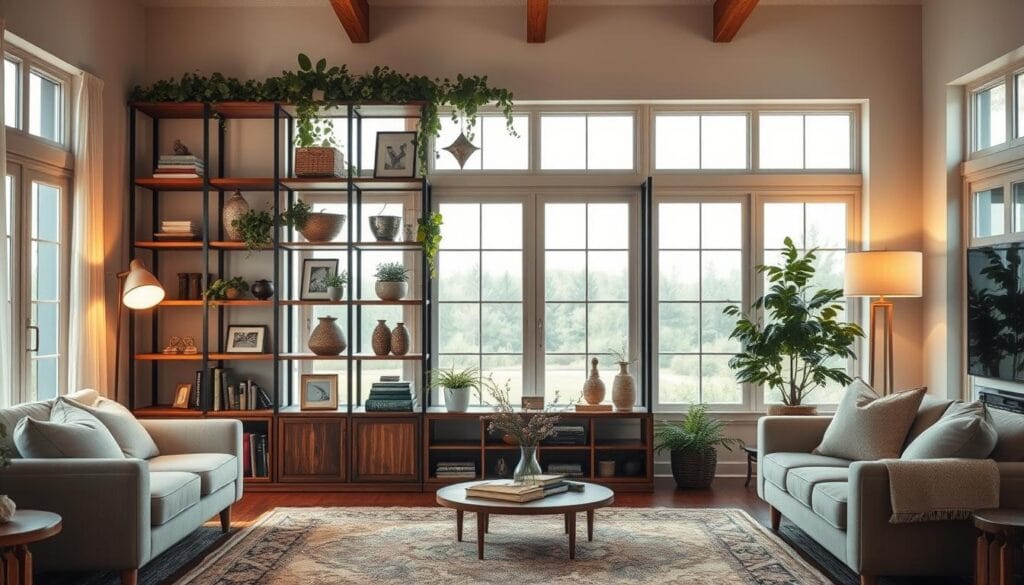
Let me show you how to reimagine your space with hands-on projects that spark joy. Whether you’re crafting wall art from scrap wood or breathing new life into thrifted furniture, these strategies deliver designer-level impact without professional skills.
DIY Tips for Custom Decor
My favorite hack? Turn old picture frames into floating shelves. Here’s how:
- Remove glass and backing from deep-set frames
- Sand and paint in your accent color
- Mount horizontally using heavy-duty brackets
For quick texture upgrades, try these ideas:
- Stencil geometric patterns onto plain curtains
- Wrap lamp bases in jute rope
- Layer paint samples into abstract wall collages
I recently helped a couple create hidden storage inside their coffee table using drawer dividers and peel-and-stick wallpaper. The transformation took one afternoon but looked like a high-end custom piece.
Remember: Great design thrives on experimentation. Mix metallic spray paints, try unexpected fabric combinations, or turn mismatched vases into a cohesive collection with unified paint drips. Your space should tell your story – one creative project at a time.
Anchor Your Space with a Statement Fireplace
Designer Hilary Colia once told me, “A great fireplace doesn’t just warm your toes – it warms the whole atmosphere.” I saw this magic firsthand in a historic home where carved marble surrounds became the natural gathering spot. Whether you’re working with original brick or a modern insert, your hearth deserves to shine as the emotional centerpiece of your home.
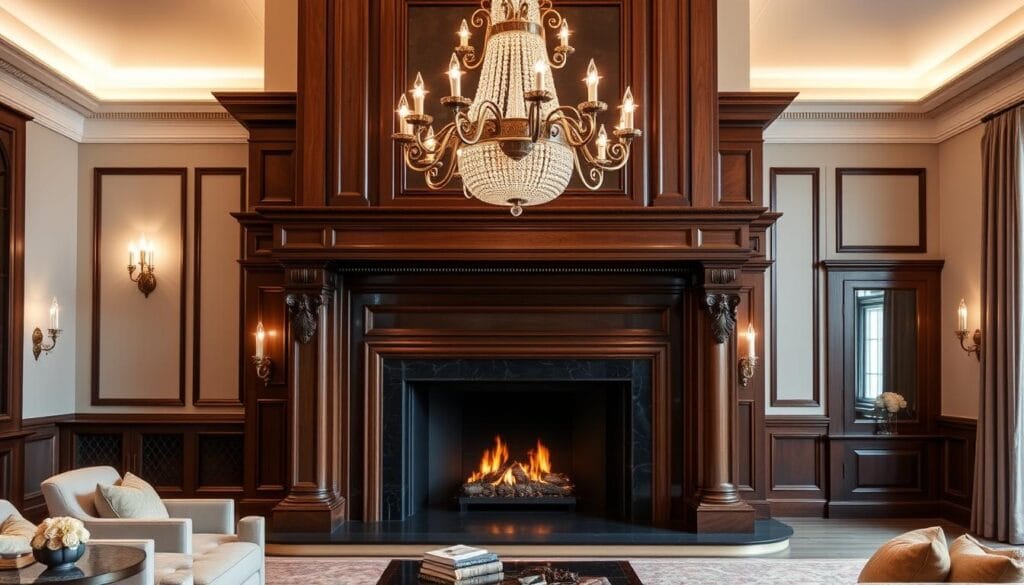
Making the Fireplace the Focal Point
Start by clearing visual clutter. I helped a client transform their unused hearth using floor-to-ceiling zellige tiles in sunset hues. The Moroccan-inspired wall now commands attention without competing with other elements. Here’s how to highlight your feature:
- Frame with symmetrical sconces or tall plants
- Use contrasting materials like matte tile against glossy walls
- Extend the surround vertically to draw eyes upward
Arrange seating in a U-shape around the hearth, leaving 36 inches for traffic flow. In smaller areas, angle two armchairs toward the flames. My favorite trick? Layer textures on the mantel – try a weathered wood mirror behind brass candlesticks and trailing ivy.
For electric units, add depth with stacked birch logs or a basket of woven throws. Remember: Your fireplace tells your home’s story. Let it speak loudly through thoughtful styling that reflects your personality.
Maximize Wall Decor Impact
A client once confessed her walls felt “naked” compared to her vibrant personality. We fixed this in one afternoon using two game-changing techniques that transformed blank spaces into visual storytelling zones. Let me show you how to turn vertical surfaces into your home’s most dynamic feature.
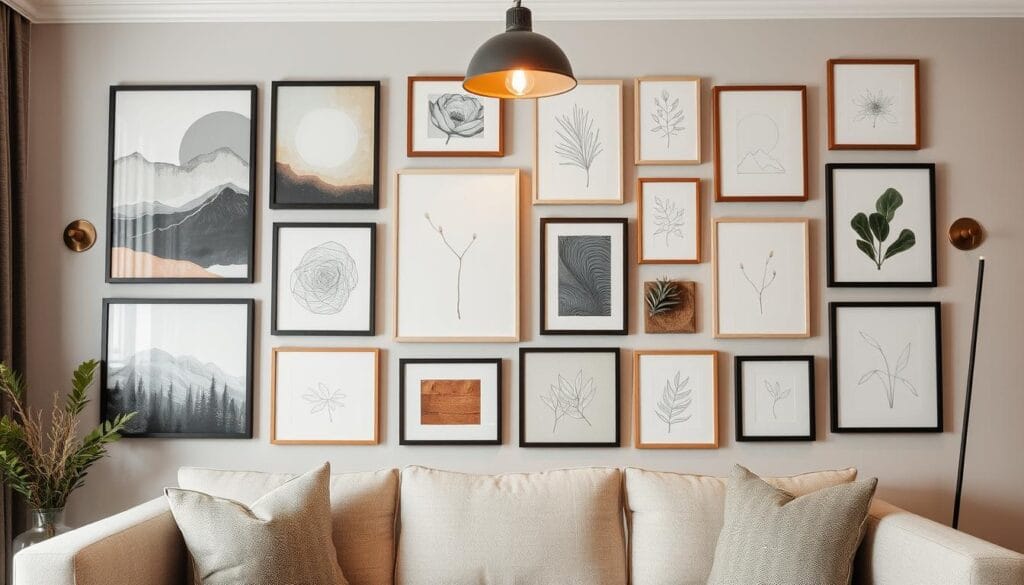
Creating an Art Stack or Gallery Wall
Art stacking changed how I approach empty walls. Layer 2-3 pieces vertically using mismatched frames – think oval landscapes above angular abstracts. My favorite combo? A vintage oil painting, modern line drawing, and woven textile in varied sizes. This creates curated chaos that feels intentional.
For larger spaces, gallery wall inspiration proves endless. Start with one bold piece at eye level, then radiate outward. Mix family photos with abstract prints and dimensional objects like ceramic plates. Pro tip: Trace paper templates first to avoid nail holes!
Incorporating Mirrors and Floating Shelves
Statement mirrors work double duty – they amplify light and become art. I’ve used Anthropologie’s Gleaming Primrose mirror to make narrow halls feel airy. Pair sculptural designs with simple frames elsewhere to prevent visual overload.
Floating shelves offer flexible styling options. Display thrifted vases beside fresh greenery or stack favorite art books horizontally. I often layer small framed prints in front of taller objects for depth. The key? Edit ruthlessly – three well-chosen items beat ten cluttered knickknacks.
Integrate Architectural Details and Built-Ins
During a recent kitchen remodel, I stumbled upon original crown molding hidden under layers of paint. That discovery sparked my love for architectural elements that add instant character to any space. Whether you’re renovating or renting, these details create depth where flat surfaces fall flat.
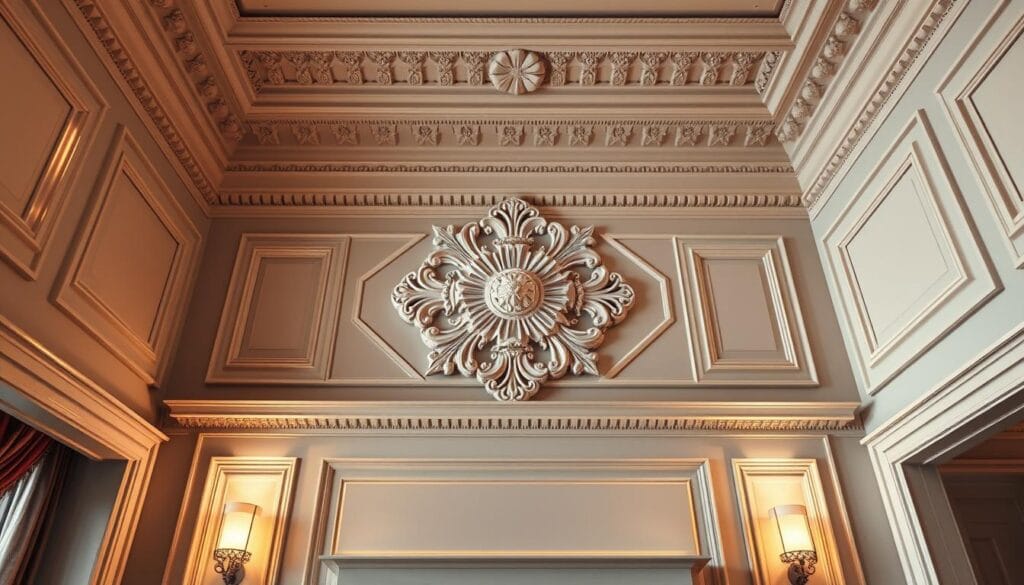
Adding Molding, Shiplap, and Paneling
Vertical lines work magic in compact areas. Board-and-batten made my client’s narrow hallway feel twice as tall last fall. For DIY-friendly upgrades:
- Use paintable PVC molding for moisture-prone rooms
- Install shiplap horizontally to widen tight spaces
- Try peel-and-stick wood panels for temporary rentals
Built-ins solve multiple problems beautifully. Beautiful built-ins like window-seat bookcases add storage while creating cozy nooks. I recently transformed an awkward alcove into a breakfast corner using floating shelves and a cushioned bench.
Remember: Scale matters. Thin trim gets lost in large rooms, while chunky moldings overwhelm small walls. Match proportions to your space, and watch ordinary rooms become extraordinary. For budget-friendly seating solutions, consider converting existing shelves into display/storage hybrids with baskets or fabric bins.
Refresh with Removable Wallpaper and Accents
Last month, a renter friend showed me her bold floral accent wall – applied during lunch and removable before her lease ends. That’s the magic of today’s peel-and-stick options! No more “what if I hate it?” stress. These temporary solutions let you test daring patterns or faux textures without commitment.
Start small: wrap the area behind your sofa in tropical leaves or moody geometrics. Prefer subtle drama? Try marble-patterned sheets behind floating shelves. I love how faux brick panels can transform a bland corner into an industrial-chic nook in one afternoon.
Here’s my favorite trick for smooth application:
- Clean walls with rubbing alcohol first
- Use a plastic smoother to eliminate bubbles
- Overlap patterns slightly at seams
Mix metallic accents with organic shapes for balance. Pair a black-and-white striped design with rattan baskets, or soften bold damask prints with linen curtains. The best part? When summer arrives, swap citrusy motifs for earthy terracotta tones in minutes.
Remember: Your space should evolve as you do. With removable options, yesterday’s minimalist gray wall becomes tomorrow’s gallery of abstract brushstrokes – no paint cans required. What pattern will your walls wear next?
Invest in Practical and Stylish
Last Tuesday, a client texted me in a panic: “Help! My new sofa looks great but feels like a museum piece – I’m scared to actually use it!” We solved this with two designer-approved strategies from professional spaces – durable performance fabrics and clever storage built into seating. The result? A space that’s both Instagram-worthy and family-proof.
I’ve learned that true style thrives when pieces work as hard as they look good. My go-to moves: ottomans with hidden compartments, washable slipcovers in rich textures, and nesting tables that tuck away post-dinner party. These choices let you live freely without sacrificing aesthetics.
One game-changer? Lightweight furniture on casters. I recently swapped a client’s heavy coffee table for a mobile butcher block cart. Now they rearrange their layout for yoga sessions or game nights in seconds. Bonus: wheels add industrial flair to traditional styles.
For lasting impact, invest in handcrafted furniture that grows more beautiful with age. A solid wood bench becomes an heirloom, while a quality rug anchors daily life with quiet sophistication. Remember: The best spaces balance beauty and brains – no museum vibes allowed.
